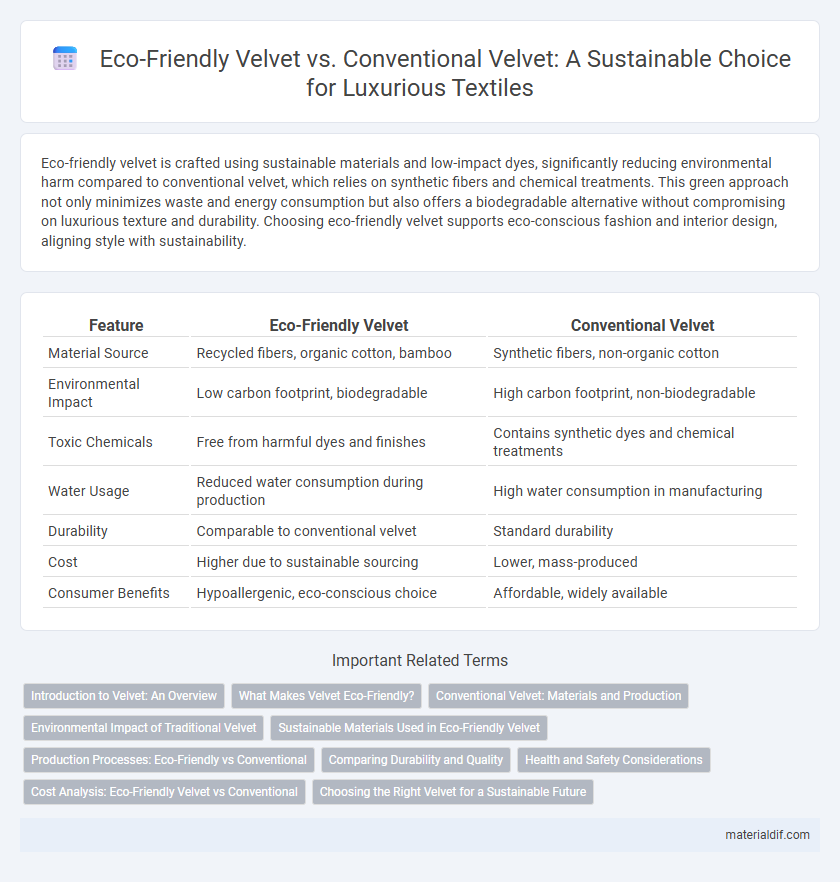Eco-friendly velvet is crafted using sustainable materials and low-impact dyes, significantly reducing environmental harm compared to conventional velvet, which relies on synthetic fibers and chemical treatments. This green approach not only minimizes waste and energy consumption but also offers a biodegradable alternative without compromising on luxurious texture and durability. Choosing eco-friendly velvet supports eco-conscious fashion and interior design, aligning style with sustainability.
Table of Comparison
| Feature | Eco-Friendly Velvet | Conventional Velvet |
|---|---|---|
| Material Source | Recycled fibers, organic cotton, bamboo | Synthetic fibers, non-organic cotton |
| Environmental Impact | Low carbon footprint, biodegradable | High carbon footprint, non-biodegradable |
| Toxic Chemicals | Free from harmful dyes and finishes | Contains synthetic dyes and chemical treatments |
| Water Usage | Reduced water consumption during production | High water consumption in manufacturing |
| Durability | Comparable to conventional velvet | Standard durability |
| Cost | Higher due to sustainable sourcing | Lower, mass-produced |
| Consumer Benefits | Hypoallergenic, eco-conscious choice | Affordable, widely available |
Introduction to Velvet: An Overview
Velvet, a luxurious fabric known for its dense pile and soft texture, is traditionally crafted from silk, cotton, or synthetic fibers. Eco-friendly velvet emerges as a sustainable alternative, utilizing organic materials, bamboo fibers, or recycled polyester to reduce environmental impact. Conventional velvet production often involves high water consumption and chemical use, whereas sustainable manufacturing prioritizes eco-conscious processes that minimize waste and pollution.
What Makes Velvet Eco-Friendly?
Eco-friendly velvet is made from sustainable materials such as organic cotton, recycled polyester, and Tencel, reducing environmental impact compared to conventional velvet, which typically relies on petroleum-based synthetic fibers. The production process of eco-friendly velvet minimizes water usage and avoids harmful chemicals, ensuring a lower carbon footprint and less pollution. Its biodegradable or recyclable nature promotes circular fashion, distinguishing it from conventional velvet that contributes to textile waste and microplastic pollution.
Conventional Velvet: Materials and Production
Conventional velvet is typically made from synthetic fibers such as polyester or nylon, which are derived from petrochemicals and contribute to environmental pollution. Its production involves energy-intensive processes and the use of toxic chemicals like dyes and solvents, leading to significant water and air pollution. This manufacturing approach results in higher carbon emissions and waste compared to eco-friendly alternatives, raising concerns about sustainability in the textile industry.
Environmental Impact of Traditional Velvet
Traditional velvet production typically involves synthetic fibers such as polyester, which are derived from non-renewable petroleum resources and contribute to microplastic pollution in water systems. The dyeing processes used in conventional velvet manufacturing often rely on toxic chemicals, generating hazardous wastewater that negatively affects aquatic ecosystems. Energy-intensive production methods and the use of heavy metals in conventional velvet also increase carbon emissions and soil contamination, amplifying its environmental footprint compared to eco-friendly alternatives.
Sustainable Materials Used in Eco-Friendly Velvet
Eco-friendly velvet utilizes sustainable materials such as organic cotton, recycled polyester, and bamboo fibers, reducing environmental impact compared to conventional velvet made from synthetic fibers like nylon or non-organic cotton. These sustainable fibers require less water, fewer chemicals, and promote biodegradability, supporting eco-conscious manufacturing processes. The integration of responsibly sourced plant-based fibers and recycled content enhances the fabric's overall sustainability and durability.
Production Processes: Eco-Friendly vs Conventional
Eco-friendly velvet utilizes sustainable fibers such as organic cotton or recycled polyester, produced with low-impact dyes and water-saving technologies, significantly reducing environmental footprint. Conventional velvet relies on synthetic fibers like polyester or non-organic cotton, often involving high water usage and toxic chemical dyes, contributing to pollution and resource depletion. The eco-friendly production process emphasizes renewable energy and waste minimization, contrasting with the conventional methods that prioritize mass production over sustainability.
Comparing Durability and Quality
Eco-friendly velvet often uses sustainable fibers like recycled polyester or organic cotton, providing durability comparable to conventional velvet made from synthetic or silk blends. The quality of eco-friendly velvet maintains a soft texture and rich pile while reducing environmental impact through non-toxic dyes and lower water consumption. Conventional velvet tends to have a slightly higher sheen and may resist wear differently, but eco-friendly alternatives increasingly match or exceed these performance standards with enhanced longevity and eco-conscious production methods.
Health and Safety Considerations
Eco-friendly velvet is made from natural fibers or recycled materials, reducing exposure to harmful chemicals and synthetic dyes common in conventional velvet production. This sustainable fabric minimizes the release of volatile organic compounds (VOCs) and toxic substances, promoting healthier indoor air quality. Choosing eco-friendly velvet supports safer textile manufacturing practices, reducing skin irritation and respiratory risks often associated with conventional velvet.
Cost Analysis: Eco-Friendly Velvet vs Conventional
Eco-friendly velvet typically incurs higher upfront costs due to sustainable raw materials and eco-conscious manufacturing processes compared to conventional velvet, which relies on cheaper synthetic fibers and mass production methods. Over time, eco-friendly velvet may offer cost benefits through durability and reduced environmental impact fees, whereas conventional velvet often leads to hidden expenses from faster wear and environmental regulations. Businesses seeking long-term savings and brand value may find eco-friendly velvet a more financially viable option despite initial price differences.
Choosing the Right Velvet for a Sustainable Future
Eco-friendly velvet is crafted using sustainable fibers like organic cotton, bamboo, or recycled polyester, reducing environmental impact compared to conventional velvet made from synthetic materials such as nylon or polyester derived from fossil fuels. The production process of eco-friendly velvet emphasizes lower water consumption, non-toxic dyes, and minimal chemical use, contributing to a smaller carbon footprint. Selecting eco-friendly velvet supports sustainability goals by promoting biodegradable or recyclable textiles and fostering responsible manufacturing practices in the fashion and interior design industries.
Eco-Friendly Velvet vs Conventional Velvet Infographic

 materialdif.com
materialdif.com